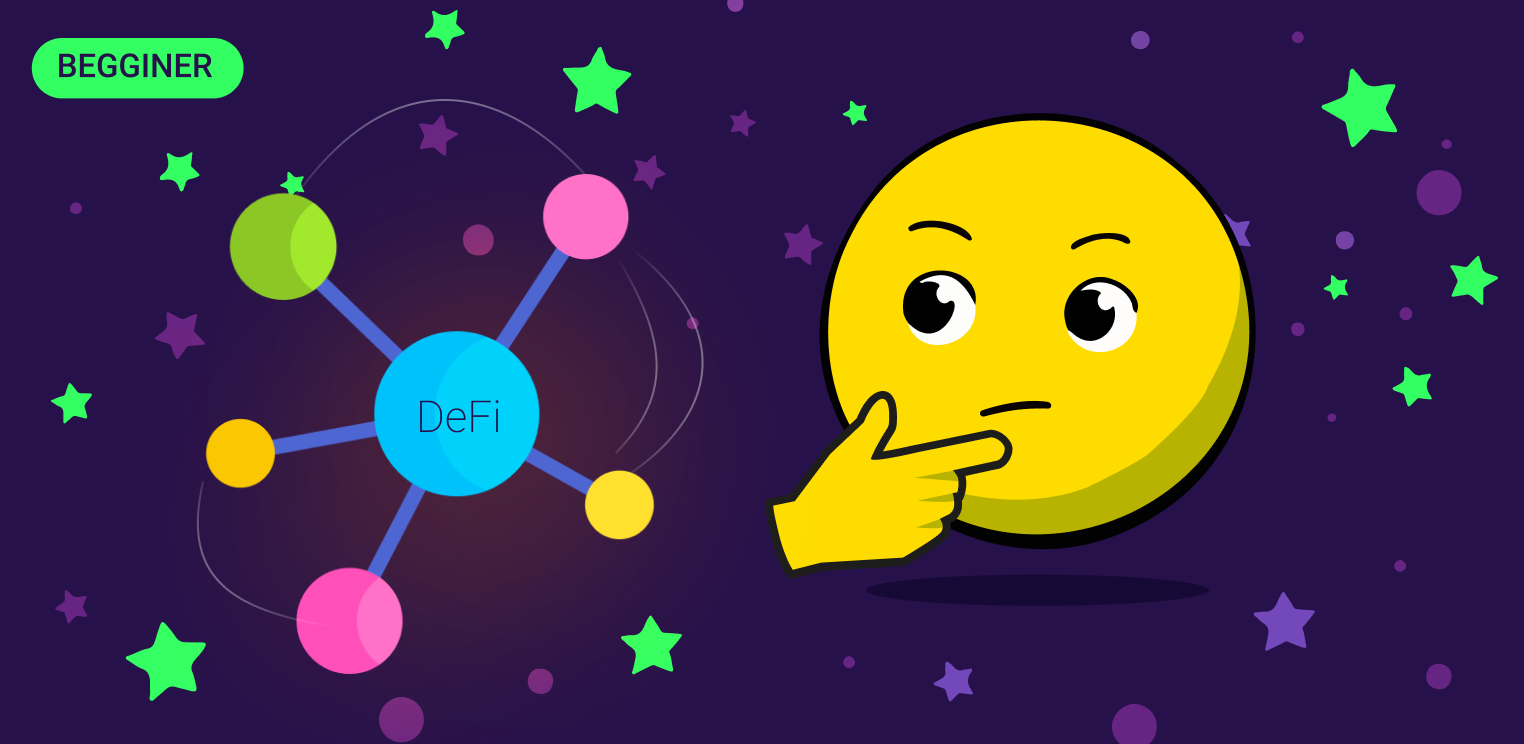
Decentralized Finance (DeFi) is a revolutionary concept that challenges the traditional approach to financial services. Rather than relying on centralized financial institutions, DeFi utilizes blockchains and smart contracts to create financial instruments that are accessible and transparent to everyone.
Decentralized finance is a collection of financial apps and services built on a blockchain, usually on the Ethereum platform. The aim is to transform the traditional finance sector, making it simpler, more accessible, and more efficient.
DeFi Basics
Decentralized finance (DeFi) is a financial system that allows clients to access services without the involvement of intermediaries. It does not involve the centralization of financial processes and flows. To achieve this, decentralized applications that typically utilize blockchain technology are created.
Financial institutions such as banks and brokers are not only involved in financial transactions but also play a crucial role in various aspects of the financial industry. They facilitate payments for services, provide loans, and enable the purchase and exchange of assets. Instead, transactions are recorded in smart contracts and executed automatically, with the owner maintaining control over the state of their finances (accounts and wallets).
DeFi projects involve a range of assets
- Cryptocurrencies are digital tokens supported by blockchain protocols that are unique to their networks. Examples of these tokens include Bitcoin (BTC), Ether (ETH), Ripple (XRP), and Polkadot (DOT).
- Application tokens function in two ways: negotiable tokens secured by crypto assets and management tokens.
- Non-fungible tokens (NFTs) and utility tokens are used as virtual assets worldwide and are metaverses.
It would be a mistake to assume that DeFi is restricted to cryptocurrencies. There has been a considerable rise in the utilization of decentralized applications and distributed ledger technologies
- for transactions related to genuine assets, e.g., tokenized national currencies;
- tokenized exchange-traded instruments such as shares, bonds, and derivatives;
- and several rights, including demand for goods, access to services, and property.
Use of Decentralized Finance (DeFi)
In the short time that the DeFi protocols have been in existence, much progress has been made. Some of the most popular use cases and protocols in space are as follows.
- Lending and borrowing
Anyone can borrow or lend digital assets using decentralized lending and borrowing protocols. You can contact lenders and borrowers directly without having to provide funds or personal information to an intermediary.
MakerDAO is one of the most popular protocols in the field. This protocol allows users to secure digital assets and then borrow against them.
- Liquidity
Liquidity Providers (LP) earn fees by providing money to decentralized exchanges such as Automated Market Makers (AMM). LPS provides this liquidity by holding the equal value of two different assets in a "liquidity pool.”
The LPS rewards a portion of the trading fees generated when users trade assets in the liquidity pool. Pancakeswap and Uniswap are the two most popular protocols for liquidity.
- Asset Management
Asset management protocols are integrated with various DeFi projects to automate the task of constantly tracking investments in price movements, rebalancing, liquidation, and rate changes. Yearn finance is a protocol that provides "smart storage" for digital assets. These repositories automatically invest users' funds in the most profitable protocols and strategies so that users can obtain the maximum possible return when growing income (using DeFi to gain interest in digital assets).
Potential in DeFi
One area of finance that can be improved with DeFi is the derivatives market, which is estimated to be worth more than $1 quadrillion, 10 times more than the global stock market.
The DeFi derivatives market has just begun to take off, and dYdX is leading the way. The total blocked value (TVL) in the DeFi derivatives market currently stands at just over US$ 3 billion. While this may not seem like a lot, it is an increase of approximately 200% in just a few years.
With the launch of new protocols and platforms, we expect this growth to continue. It is not hard to imagine that the DeFi derivatives market could be worth trillions of dollars.
Key Aspects of DeFi
The popularity of DeFi and its growing user base is because of its main features: there are no middlemen involved, and users have control of their assets at all times.
In decentralized finance applications, users are the only users with access to their assets, which heightens security. Nonetheless, if the private key – the main identification data – is lost, asset control cannot be regained.
Self-governance is attained by voting from the holders of the controlling tokens.
Transparency and openness are at the heart of DeFi platforms and projects, where everything is almost always open to scrutiny down to the source code. Transparency and openness are at the heart of DeFi platforms and projects, where everything is almost always open to scrutiny, down to the source code. The composable nature of DeFi adds to its appeal only. Any modifications are often subject to voting.
Versatility is a key feature of project tokens because it can be used on different blockchain platforms for various functional purposes. These capabilities can be extended to foreign networks by implementing cross-chain gateways.
This feature refers to the ability to create new things using smart contracts and dApps from one project. For instance, one could combine the app's abilities to bring in users and their tokens and create extra earnings for participants. Using this, one can make a new thing that plays either the whole or part of the total reward in a lottery.
DeFi, a decentralized finance technology that exists solely online, provides a real choice for conventional financial establishments. DeFi projects can significantly improve the security of personal finances and service usability. Even central banks have shown an interest in these novel technologies.
The foundation of any DeFi project is the underlying blockchain network. Currently, the Ethereum blockchain leads the pack with less than 50% of the total smart contract funds blocked. Regrettably, since 2021, their market share has decreased because of the three times higher transaction costs. The Ethereum blockchain competes with the Binance Smart Chain, Tron, and Polkadot. Solana and Avalanche blockchains have also made significant advancements.
They are required for the network to accept tokens, organize their circulation, and interact with smart contracts. In the Ethereum network, ERC-20 has become the main standard for interchangeable tokens, whereas, in the Tron blockchain, it is TRC-20.
Standards are used to form protocols that define how smart contracts are executed for various token operations. This simple text adheres to the given principles. As DeFi aims to replace traditional financial institutions, its protocols have become crucial.
Users can access the protocols at the application level. DeFi applications (dApps) provide an interface to perform operations (using protocols) and track the status of smart contracts.
The first level in this structure is the platform on which the user can select the required DeFi services and products. The platform plays a significant role in guaranteeing interaction between the two primary groups of users: service consumers and liquidity providers.
Projects and platforms are implemented in the form of Decentralized Autonomous Organization (DAO) communities that ensure the interaction of participants and decision-making mechanisms. In the full sense of the meaning of this word, DAOs are not organizations since they do not have legal registration in any form.
DAOs release governance tokens that are similar to securities that grant permission to own a portion of the project platform and participate in management.
Users can obtain these tokens by participating in funding rounds during a project's formation, receiving them for free during an airdrop, or receiving them to provide liquidity during project operations.
Existing participants or centralized or decentralized exchanges sell them.
Conclusion
DeFi continues to gain popularity, attracting increasing numbers of investors and developers. In the future, we will wait for widespread regulations to ensure the protection of user funds. We can also expect the integration of DeFi with traditional financial systems for wider application. Technical innovations aim to improve and optimize existing protocols and create solutions to increase the speed and reduce the cost of transactions. Additionally, the DeFi ecosystem will become even more diverse owing to the emergence of new products and services. In general, DeFi appears to be one of the most promising areas in the blockchain industry, and its development will actively shape the financial future.

